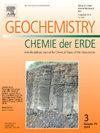In Ouzzal Terrane(阿尔及利亚南部西霍加尔)超高温钙硅酸盐花岗岩中的反应:对压力-温度-流体演化的影响
IF 2.9
3区 地球科学
Q2 GEOCHEMISTRY & GEOPHYSICS
引用次数: 0
摘要
钙硅酸盐花岗岩在 In Ouzzal 地层(阿尔及利亚南部霍加尔西北部)出露的整个花岗岩物质中只占相对较小的一部分。然而,这些岩石保留了许多壮观的反应纹理,可有效用于推断其压力-温度-流体历史。在简化的 CaO-Al2O3-SiO2-Vapor 系统中,使用 P-T 和 T-XCO2 网格对这些纹理进行了解释。在这一过程中,反应序列被细分为两个不同的阶段:(i) 伴随着温度从大约 800 °C 显著上升到 1050 °C(大约 10 千巴)的早期顺行阶段;(ii) 从大约 9 千巴到 6 千巴的减压阶段。在上升阶段,根据方解石+石英→硅灰石+二氧化碳的反应生成了粗粒硅灰石。此外,在峰值压力温度阶段,根据 3grossular + 3CO2 → 3wollastonite + 2calcite + scapolite 反应,从粗原生石榴石中生成硅灰石+霞石的反应消耗二氧化碳,温度从 850 ℃ 升至 1000 ℃。最新的反应发生在从大约 10 千巴减压到 5 千巴以及从 1000 °C 冷却到 800 °C 的阶段。硅灰石周围方解石和石英的生长,以及硅灰石、方解石和鳞片矿之间的石榴石冠,可以用以下反应来解释:方解石+石英→硅灰石+CO2,3硅灰石+鳞片矿+2方解石→3毛玻璃+3CO2。根据沸石 → 3沸石 + 方解石的反应,在沸石周围出现阳起石是随着温度的降低而发生的,与流体无关。所有反应都发生在二氧化碳低压条件下,估计压力在 0.04 至 0.55 之间。本文章由计算机程序翻译,如有差异,请以英文原文为准。
Reactions in UHT calc-silicate granulites from the In Ouzzal terrane (Western Hoggar, South Algeria): Implication for pressure-temperature-fluid evolution
Calc-silicate granulites constitute a relatively small part of the whole granulitic material outcrops characterizing the In Ouzzal terrane (NW Hoggar, South Algeria). However, these rocks preserve a number of spectacular reaction textures that could be effectively used to infer their pressure-temperature-fluid history. These textures are interpreted using P-T and T-XCO2 grids in the simplified CaO-Al2O3-SiO2-Vapor system. In this process, sequences of reactions have been subdivided into two distinct stages: (i) the early prograde stage that was accompanied by significant rise of temperature from about 800 °C up to 1050 °C at around10 kbar followed by (ii) the decompression stage from about 9 to 6 kbar. During the prograde stage, coarse grained wollastonites were produced according to the reaction calcite + quartz → wollastonite + CO2. Furthermore, in the peak pressure temperature stage, the reaction producing wollastonite + scapolite from coarse primary garnet consumes CO2 with temperature increasing from 850 °C to 1000 °C according to the reaction 3grossular + 3CO2 → 3wollastonite + 2calcite + scapolite. The latest reactions have been occurred during the decompression stage from about 10 kbar to 5 kbar and cooling from 1000 °C to 800 °C. The growth of calcite + quartz around wollastonite besides to garnet coronas between wollastonite, calcite and scapolite are explained by the reaction: calcite + quartz → wollastonite + CO2 and 3wollastonite + scapolite +2calcite → 3grossular + 3CO2. The appearance of anorthite around scapolite occurs following a decrease of temperature independently to the fluids according to the reaction scapolite → 3anorthite + calcite. All reactions took place at CO2 low pressure which was estimated between 0.04 and 0.55.
求助全文
通过发布文献求助,成功后即可免费获取论文全文。
去求助
来源期刊

Chemie Der Erde-Geochemistry
地学-地球化学与地球物理
CiteScore
7.10
自引率
0.00%
发文量
40
审稿时长
3.0 months
期刊介绍:
GEOCHEMISTRY was founded as Chemie der Erde 1914 in Jena, and, hence, is one of the oldest journals for geochemistry-related topics.
GEOCHEMISTRY (formerly Chemie der Erde / Geochemistry) publishes original research papers, short communications, reviews of selected topics, and high-class invited review articles addressed at broad geosciences audience. Publications dealing with interdisciplinary questions are particularly welcome. Young scientists are especially encouraged to submit their work. Contributions will be published exclusively in English. The journal, through very personalized consultation and its worldwide distribution, offers entry into the world of international scientific communication, and promotes interdisciplinary discussion on chemical problems in a broad spectrum of geosciences.
The following topics are covered by the expertise of the members of the editorial board (see below):
-cosmochemistry, meteoritics-
igneous, metamorphic, and sedimentary petrology-
volcanology-
low & high temperature geochemistry-
experimental - theoretical - field related studies-
mineralogy - crystallography-
environmental geosciences-
archaeometry
 求助内容:
求助内容: 应助结果提醒方式:
应助结果提醒方式:


